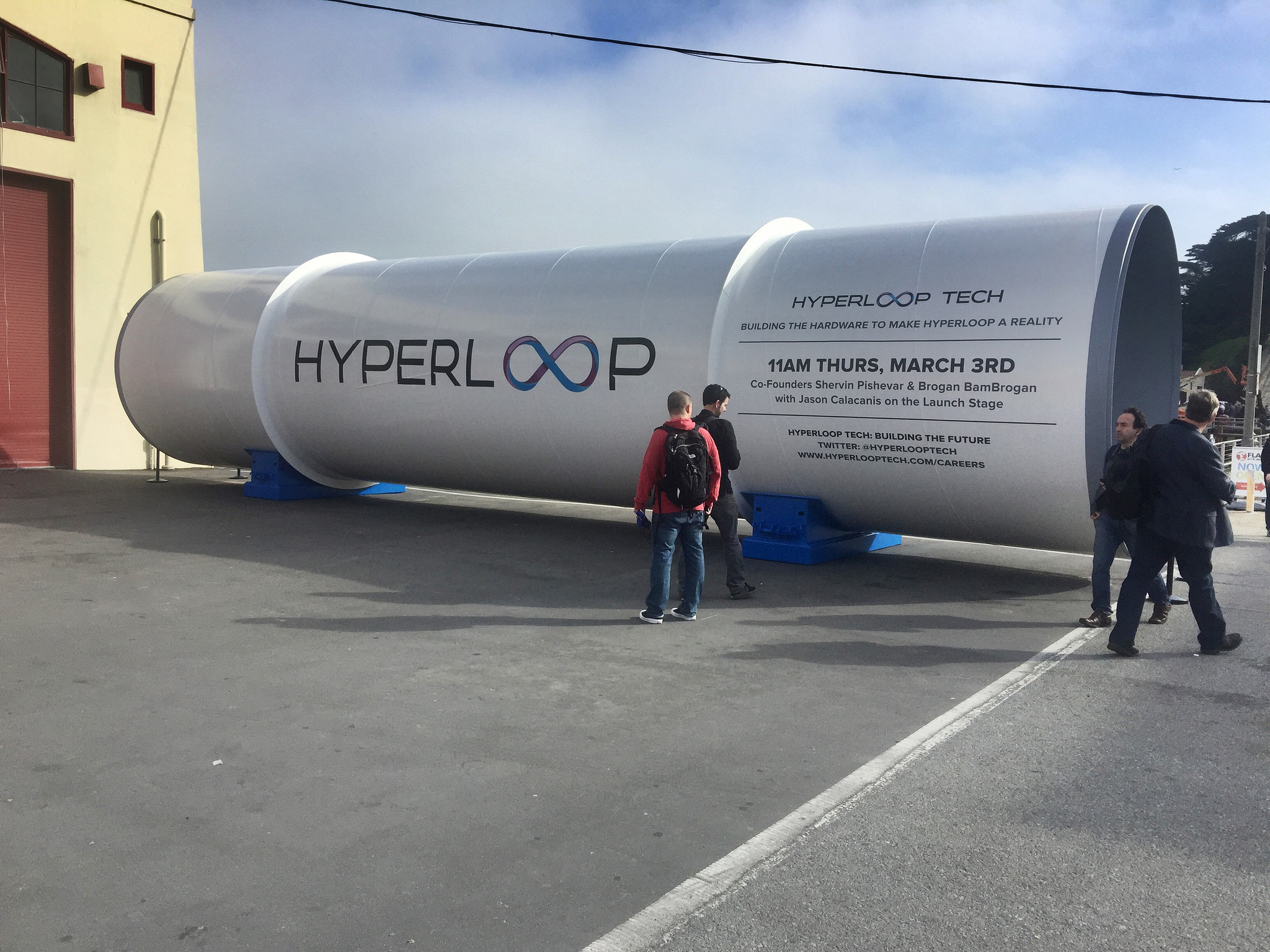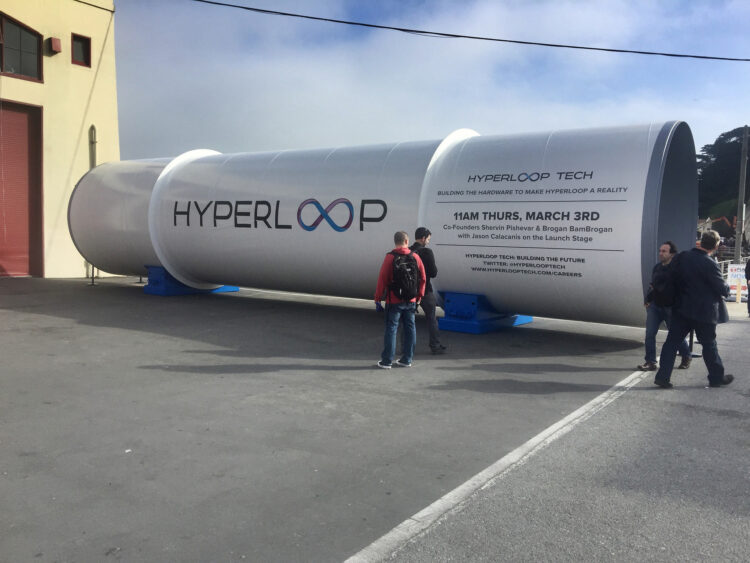
Elon Musk had a rough week with the announcement of Tesla’s acquisition of his other company, SolarCity, for $3 billion. Following the announcement, the carmaker’s stock plummeted. However, Musk continued to persevere with his vision of an oil-free autonomous future as his other portfolio holding, Hyperloop One, an autonomous electric transportation system moved one step closer to deployment. This comes on the heels of a successful 700 mph test in the desert last month.
Musk envisions a day when Hyperloop will replace The Orient Express linking Asia to Europe in a day’s ride. However, the area under immediate evaluation for this new supersonic train is the busy corridor between Moscow and St. Petersburg, a distance of over 400 miles. Hyperloop, which announced that it has partnered with a Russian firm to explore building transcontinental routes, will begin replacing Moscow’s ailing subway and train network (concept drawing below).
“We are excited for the partnership between the Summa Group, the Russian Government and Hyperloop One to construct a Hyperloop in Moscow,” said Hyperloop One cofounder Shervin Pishevar in a statement.
Pishevar noted the two companies and the city of Moscow were eager to explore how hyperloop transportation—which, in its perfected state, promises to whisk goods and people at up to 800 mph in pods inserted into vacuum-sealed tubes, could improve life dramatically for the 16 million people in the greater Moscow area; cutting their commute to a fraction of what it is today. That transcontinental goal seems to square with the technology’s need for long and straight runs in order to get the pods up to speed.
Hyperloop is just one example of recent autonomous innovations seeking to disrupt an antiquated global transportation network. Another scion of Silicon Valley, Eric Schmidt of Google is an early investor in skyTran. skyTran, a NASA Space Act company headquartered at the NASA Ames Research Center near Mountain View, California, is a patented, high-speed, low-cost, elevated Personal Rapid Transportation (PRT) system. The skyTran network of computer-controlled, 2-person “jet-like” vehicles employs unique, state-of-the-art, SkyTran Magnetic Levitation (STML) technology. skyTran moves passengers in a fast, safe, green, and economical manner.
skyTran came closer to deploying its novel autonomous gondola-type system in Clearwater Florida. Last month, the city council heard a presentation by private citizen Tom Nocera for a proposal he dubbed “BeachTran.” According to Nocera, the system could carry as many as 1,250 people to and from the beach each hour.
“It’s ingenious,” Nocera said of the technology. “It’s low-cost and it’s going to be revolutionary in regards to this form of transportation.”
The technology is not currently in use anywhere, but is under further development in Israel, said Nocera, who said he has a degree in aerospace management and crewed for the Apollo 11 space mission. Nocera, who did not provide a cost estimate for the project, proposed that the city form a private-public partnership as a means to fund and construct the transit system. According to Nocera, the technology is solar-powered, economical and would be quick to construct. He gave the council an operating date of December 24, 2018, should the city move forward with the proposal. Following Nocera’s presentation, council members refrained from offering comment and took no action on his proposal. Even at lightning speed, bureaucracy still moves at a snail’s pace…
Ironically, it may be Washington DC that implements the first autonomous mass transit network in the USA. Yesterday, IBM announced that it was partnering with Local Motors to bring its Watson cognitive computing system to their Olli autonomous bus. The vehicle was demoed at Local Motors facility in National Harbor, Maryland by its CEO, John Rogers.
Olli, which looks like a extra-large minivan, can transport up to 12 passengers autonomously around the nation’s capital. Watson is being deployed to “improve the passenger experience and allow natural interaction with the vehicle.” Using Watson, passengers will be able to talk to the bus with requests such as “Olli, can you take me downtown?” to start their ride. In addition, they can also inquire about the vehicle functionality, places to visit along the route, and even get recommendations for restaurants.
The launch of Olli marks the first time a vehicle has used IBM Watson. Specifically, it uses four specific Watson APIs: Speech to Text, Natural Language Classifier, Entity Extraction, and Text to Speech. Using Watson, the car will be able to analyze the transportation data that it collects from more than 30 embedded sensors. Sensors will be added and adjusted as needed while Olli is further developed.
“Olli with Watson acts as our entry into the world of self-driving vehicles, something we’ve been quietly working on with our co-creative community for the past year,” Rogers said. “We are now ready to accelerate the adoption of this technology and apply it to nearly every vehicle in our current portfolio and those in the very-near future.”
As of late June, Olli will be used on public roads locally in Washington DC, moving to Miami and Las Vegas later this year. According to a press release, Miami-Dade County is officially exploring a potential pilot program where it uses a fleet of autonomous vehicles to transport people around the city. Miami-Dade County Mayor Carlos Gimenez said that the initiative is part of a bigger project to make the city more livable and sustainable.
“We must do more to improve transit and mobility in our community and the deployment of autonomous vehicles is a big step in the right direction,” Gimenez said.
Olli was launched in tandem with the new Local Motors National Harbor facility in Maryland, where the company displays its 3D-printed vehicles and a large-scale 3D printer, along with public education programs for STEM subjects.
The original Olli will stay at the National Harbor facility over the summer, where the public will be able to interact with it. And another Olli is being built at the Local Motors’ headquarters near Phoenix, Arizona.
Mass Transit initiatives are not limited to next generation trains or buses, even General Motors is getting into the act, as they recognized that the future of autonomous vehicles are inevitably linked with ride-sharing services. As a result, GM has invested more than $1 billion this year in autonomous vehicle technologies, as well as shared mobility services such as Lyft Inc., and its new Maven ride-sharing service.
“We do feel that the car sharing is going to significantly increase in the future,” said Stapleton, adding not all vehicles entering its Maven fleet are new vehicles. He said some are coming off two-year leases or out of rental fleets. “It’s almost you get a double benefit in some ways. That’s how we’re running the Maven business right now,” said John Stapleton, North America CFO of GM.
Many industry analysts see ride sharing as a gateway to a fully autonomous future in urban markets. While many industry insiders are concerned about the drop in personal car sales, Stapleton views ride-sharing “as an opportunity for General Motors to grow our market share in the cities with autonomous vehicles.”
While we wait for cities to evolve their transit systems into energy efficient autonomous platforms, the more immediate demand might be robotic TSA agents as we all head to the beach for vacation.
Image credit: CC by Kevin Krejci



